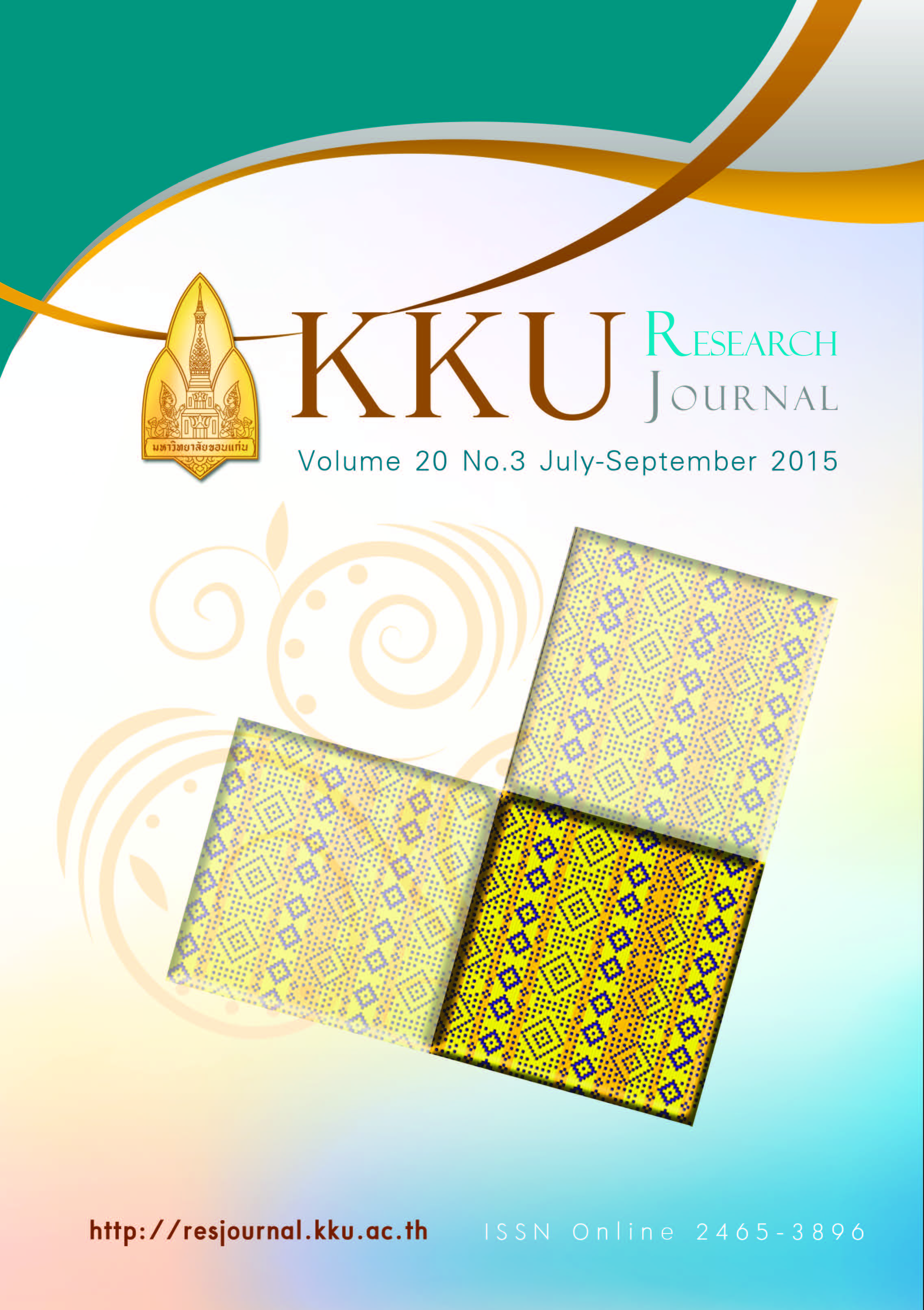Observation of Fe(III) configurations of cytochrome c confined in mesoporous materials
Main Article Content
Abstract
Proteins and enzymes immobilized in confined surroundings of mesoporous materials will develop their structures that are different from those of native solution states. In some cases, the enzymatic activity is shown to be improved when compared to the native solution state. Cytochrome c (cytc) can be used to catalyze the oxidation of some organic substrates in the presence of hydrogen peroxide, i.e. peroxidase-like activity. Immobilization of cytochrome c in mesoporous materials shows improvement of the peroxidase activity. The enhanced activity is reported to be related to the spin configuration of Fe(III) at the active site. In this review, the relationship of the Fe(III) configuration of cytc and the peroxidase activity is discussed. The knowledge on structure-activity of cytc is studied as a model for developing the bio-nano material composites providing better activity of the enzymes.
Article Details
References
[2] Carlsson N, Gustafsson H, Thorn C, Olsson L, Holmberg K, Akerman B. Enzymes immobilized in mesoporous silica: a physical-chemical perspective. Adv Colloid Interface Sci. 2014;205:339-60.
[3] Kresge CT, Leonowicz ME, Roth WJ, Vartuli JC, Beck JS. Ordered mesoporous molecular sieves synthesized by a liquid-crystal template mechanism. Nature. 1992;356(6397):710-2.
[4] Hartmann M. Ordered mesoporous materials for bioadsorption and biocatalysis. Chem Mater. 2005;17:4577-93.
[5] Humphrey HPY, Wright PA. Enzymes supported on ordered mesoporous solids: a special case of an inorganic-organic hybrid. J Mater Chem. 2005;15:3690-700.
[6] Slowing I, Trewyn BG, Lin VS-Y. Effect of surface functionalization of MCM-41-type mesoporous silica nanoparticles on the endocytosis by human cancer cells. J Am Chem Soc. 2006;128:14792-3.
[7] Vallet-Regi M, Ruiz-Gonzalez L, Izquierdo-Barba I, Gonzalez-Calbet JM. Revisiting silica based mesoporous material: medical applications. J Mater Chem. 2006;16:26-31.
[8] Hudson S, Magner E, Cooney J, Hodnett BK. Methodology for the immobilization of enzymes onto mesoporous materials. J Phys Chem B. 2005;109:19496-506.
[9] Scott RA. Cytochrome c: A Multidisciplinary Approach. In: Mauk AG, editor; 1996. 738 p.
[10] Lee C-H, Lang J, Yen C-W, Shih P-C, Lin T-S, Mou C-Y. Enhancing stability and oxidation activity of cytochrome c by immobilization in the nanochannels of mesoporous aluminosilicates. J Phys Chem B. 2005;109(12277-12286).
[11] Chia-Hung Lee C-YM, Shyue-Chu Ke, Tien-Sung Lin. Effect of spin configuration on the reactivity of cytochrome c immobilized in mesoporous silica. Mol Phys. 2006;104(10-11):1635-41.
[12] Humphrey HPY, Botting; CH, Botting; NP, Wright PA. Size selective protein adsorption on thiol-functionalised SBA-15 mesoporous molecular sieve. Phys Chem Chem Phys. 2001;3(15):2983-5.
[13] Xiao Y, Guan B, Wang X, Wu Z, Liu Y, Huo Q. The performance of mesoporous organosilicas with phenyl groups in Heme protein immobilization. New J Chem. 2015;39:739-45.
[14] Banci L, Bertini I, Gray HB, Luchinat C, Reddig T, rosato A, et al. Solution structure of oxidized horse heart cytochrome c. Biochem. 1997;36:9867-77.
[15] Cowley AB, Lukat-Rodgers GS, Rodgers KR, Benson DR. A possible role for the covalent heme-protein linkage in cytochrome c revealed via compar-ison of N-Acetylmicroperoxidase-8 and a Synthetic monohistidine-coordinated heme peptide. Bio-chem. 2004;43:1656-66.
[16] Phong PH, Yamamoto M, Kakiuchi T. Dependence of the redox reaction of cytochrome c on the mixing state of binary self-assembled monolayers composed of 11-amonoundecan-ethiol and 10-mercaptoundecanoic acid of Au(111). Sci Tech Adv Mater. 2006;7(6):552-7.
[17] Yue H, Waldeck DH. Understanding interfacial electron transfer to monolayer protein assemblies. Curr Opin Solid State Mater Sci. 2006;9(1-2):28-36.
[18] Yue H, Waldeck DH, Petrovic J, Clark RA. The effect of ionic strength on the electron-transfer rate of surface immobilized cytochrome c. J Phys Chem B. 2006;110(10):5062-72.
[19] Tinoco R, Vazquez-Duhalt R. Chemical modification of cytochrome c improves their catalytic properties in oxidation of polycyclic aromatic hydrocarbons. Enzyme Microb Tech. 1998;22:8-12.
[20] Zamocky M, Garcia-Fernandez Q, Gasselhuber B, Jakopitsch C, Furtmuller PG, Loewen PC, et al. High conformational stability of secreted eukaryotic catalase-perox-idases: answers from first crystal structure and unfolding studies. J Biol Chem. 2012;287(38):32254-62.
[21] Deere J, Magner E, Wall JG, Hod-nett BK. Oxidation of ABTS by silicate-immobilized cytochrome c in nonaqueous solutions. Biotech-nol Prog. 2003;19:1238-43.
[22] Deere J, Magner E, Wall JG, Hodnett BK. Adsorption and activ-ity of proetines onto mesoporous silica. Catal Lett. 2003;85(1-2):19-23.
[23] Oellerich S, Wackerbarth H, Hilder-brandt P. Conformational equilibria and dynamics of cytochrome c induced by binding of sodum dodecyl sulfate monomers and micelles. Eur Biophys J. 2003;32:599-613.
[24] Oellerich S, Lecomte S, Paternostre M, Heimburg T, Hildebrandt P. Peripheral and integral binding of cytochrome c to phospholipids vesicles. J Phys Chem B. 2004;108:3871-8.
[25] Ono T, Goto M. Peroxidative catalytic behavior of cytochrome c solubilized in reverse micelles. Biochem Eng J. 2006;28:156-60.
[26] Nakanishi K, Tomita M, Kato K. Improvement in the catalytic activity of cytochrome c by immobilisation on a novel mesoporous silica sheet. RCS Advances. 2014;4:4732-5.
[27] Kao K-C, Lee C-H, Lin T-S, Mou C-Y. Cytochrome c covalently immobilized on mesoporous silicas as a peroxidase: Orientation effect. J Mater Chem. 2010;20:4653-62.


